Guppy: types, care and recommendations for breeding
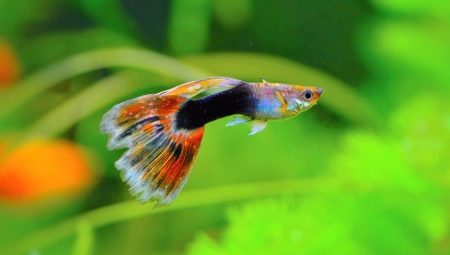
Aquarium keeping is a complex science, but guppies are so common aquarium fish that even those who have never dreamed of their own aquarium have heard of them. Unpretentious pets are often chosen by beginners to start, and yet you should get to know them better before settling them in your own pond.
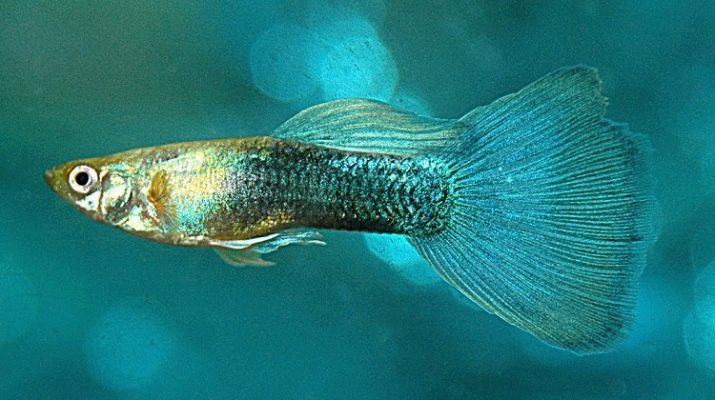
Description
Guppies are rightly considered the least whimsical aquarium fish, because they get along well in an aquarium in any layer. Individuals of different sexes are quite different from each other. Males are noticeably smaller than their girlfriends in size (1.5-4 cm in length versus 3-7 cm), but look much brighter, since females are usually gray in color.
Experts note that in captivity, "gupeshki" grow to sizes that they cannot reach in the wild.
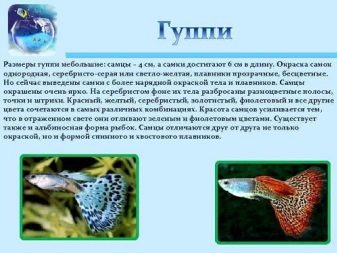
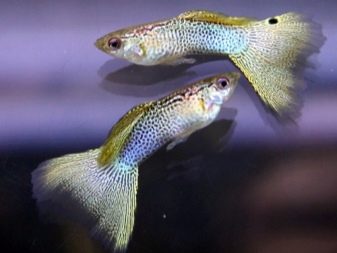
Initially, these fish lived in fresh and brackish water bodies of Venezuela and the adjacent islands of the Caribbean Sea. Scientists have noticed that such living creatures reduce the population of the anopheles mosquito, as they feed on its larvae, which grow in the water. This property turned out to be so valuable that the fish was acclimatized in all regions, where the range of water temperatures in rivers and lakes only allows.
In Russia, of course, the conditions are unsuitable, however, in the Moscow River and the environs of some Volga cities, feral guppy populations are found.Apparently, once it was released by aquarists, now it reproduces itself and lives, focusing on the places where heated wastewater is discharged.
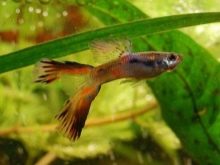

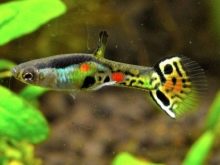
This species got its name in honor of the British priest Robert John Lechmer Guppy, combining soul-saving activities with scientific. It was he who, in 1886, made a speech before the Royal Society and reported on a fish that does not spawn like its relatives, but gives birth to live babies. Contrary to popular belief that at the end of the nineteenth century, science was already quite developed, pundits ridiculed Guppy for such statements. Only a little later was the amazing fact of the existence of viviparous fish proved.

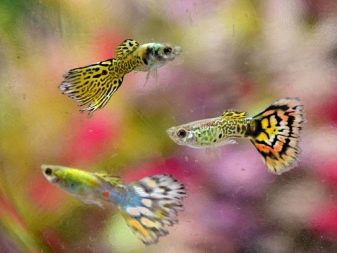
Review of popular breeds
Contrary to popular belief caused by the external diversity of such pets, guppies are one species, not several. Varieties are called breeds, that is, they do not occur in the wild, but are the result of targeted selection by humans to obtain special characteristics, which in most cases represent a color change. Professional breeders, in order to develop a new breed, start from a limited group of individuals with interesting features, and sometimes a completely unique individual becomes the basis for a new subspecies.
It should be noted that the distinguishing features of the new breed are usually the color (mainly for males, since females are dim), body shape and size, as well as the tone of the fins. The predominant part of the breeds is named by color, but most often the name is given not by the shade of the body, but by the color of the tail. This criterion allows you to distinguish white, gold, red, blue, silver and other guppies.
An alternative classification is guided in the choice of names by the shape of the caudal fin. Here the names also speak for themselves, there are fan-tailed, veil-tailed, shovel-tailed, lyre-tailed and other species of fish.
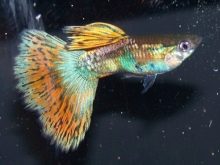
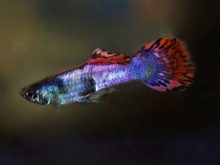
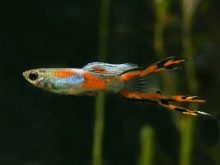
Life span
Most aquarists who decide to add these beautiful little fish to their home pond are interested in the question of how long the lifespan of this species is. There is no definite answer, since much depends on the characteristics of the content. It is generally accepted that the average "gupeshka" lives for about 2 years, but if for the male "ceiling" is considered 3 years, then the female can live even four. It is noted that in an aquarium, a fish lives on average a little longer than in nature.
This unpretentious animal feels best at a water temperature in the range of 22-25 ° C... At home, the temperature may turn out to be higher, especially if the "wise" beginner decides that such warming is beneficial for the tropical guppy, and he is greatly mistaken in this.
With excessive heating, the fish does not feel worse, however, the metabolism in its body accelerates, which means that the pet will age faster than you might expect.
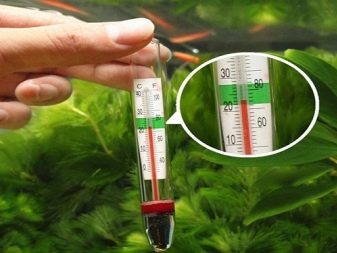
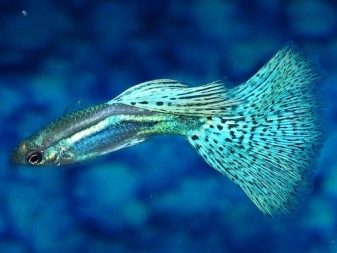
Having learned about this feature, many inexperienced aquarists go to the opposite extreme, they begin to keep their pet in the coolest water possible, knowing that even 19 ° C is not a problem for the "gupeshka". If you never lower the temperature below that specified, then this approach may still be appropriate. But it is important to know when to stop, because the fish will not become immortal anyway, and with your excessive zeal you can catch a cold poor fellow.
The experience of experienced aquarists also suggests that a fish is "sad" alone and lives on average less than in the company of its own kind.
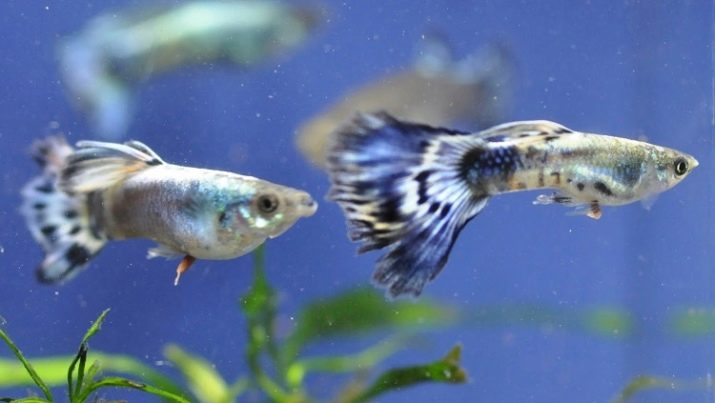
Features of the content
Guppy is an unpretentious pet, but this common truth often goes to the detriment of the fish, since some owners believe that it can be kept almost in a bank. For a pet, you need to create certain conditions, without which she will die immediately or simply will not live long, and it will not be difficult to achieve the required conditions.

Aquarium volume
Start by purchasing a suitable aquarium. You should know that this species is distinguished by increased activity and its representatives love to "drive" around the territory. For all the modestness of the body size of the guppy in a container with a volume of 20 liters, no more than three individuals can be kept. If the container is large enough and there is enough space, then as many as 300 males or 100-150 females can be settled in 100 liters of water.
It should be borne in mind that babies are prone to very rapid reproduction, and therefore only one male is usually selected for 2-3 females, even if the color of the aquarium decreases from this.

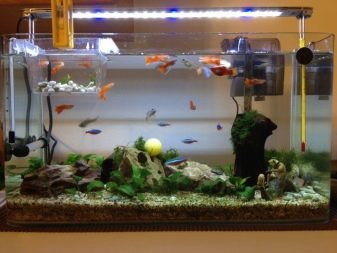
Water characteristics
Theoretically, guppies feel fine in water with a temperature of 19-29 ° C degrees, but the optimal range is 22-25 ° C, as already mentioned. Sharp changes should not be allowed, even within the declared norm, as this will adversely affect the health of the fins in males. The same applies to other key parameters, which include hardness (optimally 10-12 ° F) and pH (6.5-8.5).
Considering the negative reaction of pets to sudden changes, experts advise to carry out water changes more often so that the mass of the replaced fluid is less. You can replace no more than a third of the volume at a time, and this should be done weekly.
You may not immediately understand that the characteristics of the water have changed, but the fish simply cannot help but feel it. To check the condition, it is worth buying special tests sold in pet stores, and experienced owners simply grow Indian ferns in the aquarium. In water suitable for guppies, it grows normally in the bottom area, but when the main indicators deteriorate, the roots rot, and the plant rises to the surface or dies altogether. Nevertheless, the rule of refusal to abrupt changes in water characteristics applies in any case.
Even if the liquid is not good for anything, it is unacceptable to change the entire volume abruptly.
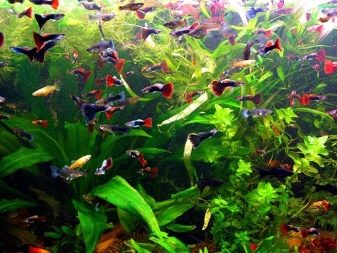
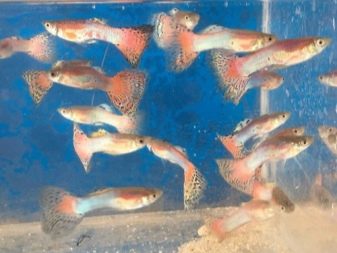
It is curious that the "gupeshki" love salt. Experienced aquarists advise adding a tablespoon (no slide!) for 10 liters of water. When changing the water, the amount of salt is calculated based on the volume of liquid added, not the entire aquarium.
These tropical fish do not like strong currents, therefore, when choosing filters, you should give preference to those that diffuse the outlet stream. It is desirable to illuminate the water depths with light of moderate intensity, the duration can reach 12 hours a day.
Aeration is controversial. On the one hand, guppies are so good that sometimes they survive even without her, on the other, why have pets so that they suffer. In any case, these fish cannot live completely without oxygen, and if your aquarium is equipped with a tight lid that blocks the natural contact of the water surface with the atmosphere, then an aerator or filter with oxygen saturation function is a must.
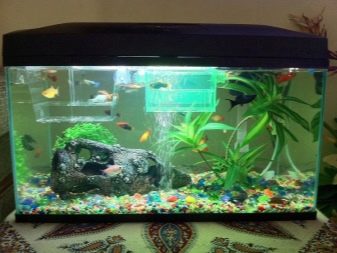
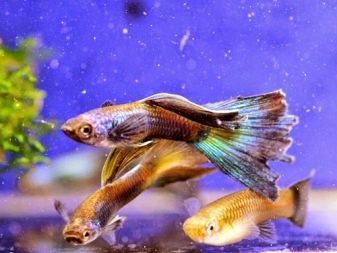
Compatibility with other fish
Experienced aquarists prefer to maintain an entire underwater world with biodiversity. "Gupeshki" are very good in this regard, because they are non-conflicting and ready to share living space with other fish. But their peacefulness does not go well with the aggression of predatory species, which, if their size allows, will gladly feast on their smaller counterparts.
With this in mind, you need to select the inhabitants of the aquarium so that guppies do not collide with predators, and, if possible, with larger peaceful fish.
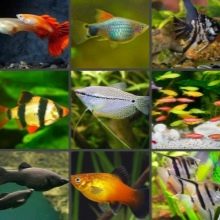

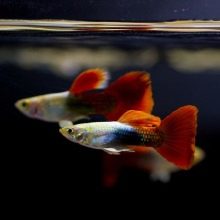
Nutrition
In terms of nutrition, these pets belong to the gourmet category. They feel better if different types of feed are used. Dry mixes should be alternated with live food, such as daphnia or bloodworms.
Experts pay special attention to the fact that breeds bred by breeding in most cases have reduced adaptability, therefore they should be looked after especially diligently, not allowing any deviations from the ideal conditions of detention.
Albinism and excessively dark pigmentation can be considered extremes, it is these "gupeshki" that will die in the first place.
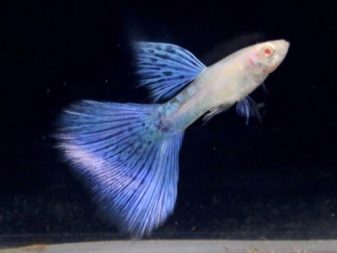
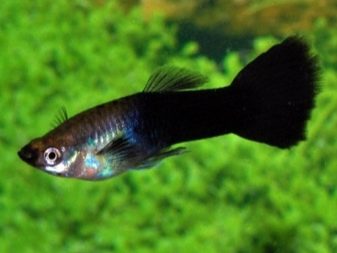
Differences between male and female
Distinguishing male from female is a key skill for the hobbyist who has decided to breed guppies. It is necessary at least in order to correctly calculate the volume of water per population, and for mixing pairs, this is also a useful skill. Usually, differences are observed in representatives of different sexes already starting from one week of age... It is clear that with the small size of the fry, and even in motion, it is not so easy to understand who is who, but you can study them through a magnifying glass.
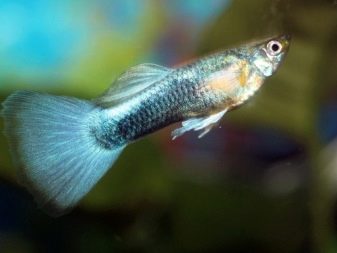
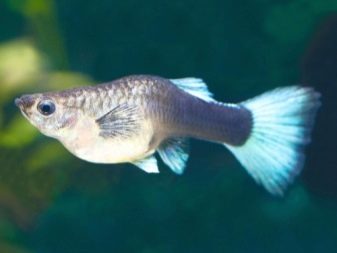
Body shape
The female bears not just eggs, but full-fledged live fry, therefore even during the absence of pregnancy, it has a well-defined abdomen, which in an "interesting position" increases even more and makes the fish look like a small barrel.
The male is, on average, shorter than his girlfriend and is distinguished by an exponential slenderness.

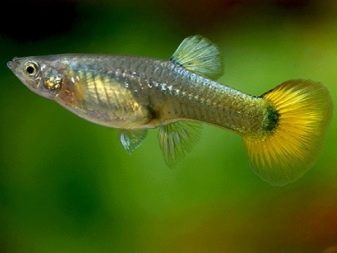
Torso size
If you are sure that individuals of a purely one breed are represented in your population, you can and should be guided by the dimensions. The male has the simplest tasks: to convey genetic material to the female and quickly swim away from enemies. That's why it is nimble and small, the average length is 3 cm.
Female representatives must bear babies, for this a certain place is provided in their body, and the length of the female can reach a well-visible 6 cm. If all pets really belong to the same breed, the ruler may not be used, the "gupeshki" may be smaller than the stated sizes, but the difference in the dimensions of opposite-sex individuals will be obvious
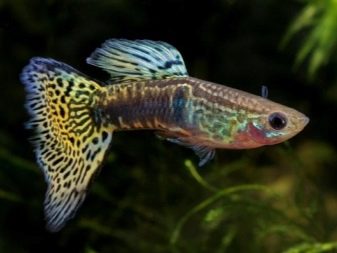
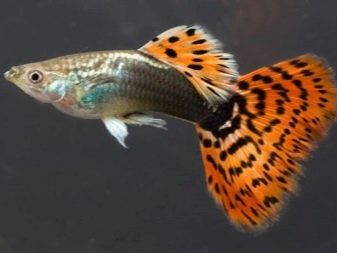
Color
In the wild, it is the male who must conquer the female with his appearance, because the guppy boy impresses his friends with bright colors, monochromatic, speckled or striped. But people who want to add as much color to their tank as possible have worked for decades to breed the picturesque females. For this reason, the color does not always allow us to determine the sex of the fish accurately, it can only confirm the conclusions drawn from other signs.
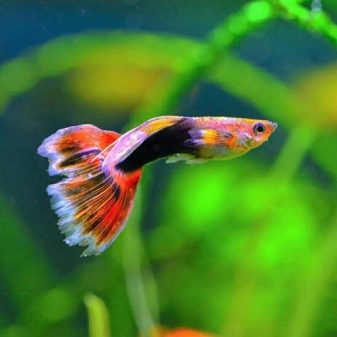
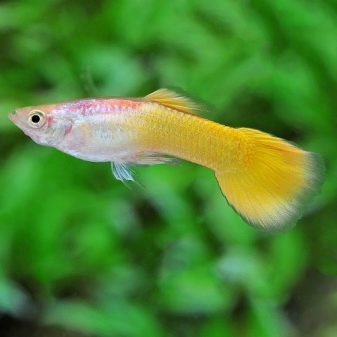
"Pregnancy Spot"
In females, the place where she bears fry looks like a speck of a different color, located in the lower abdomen closer to the tail, and is clearly visible. During the gestation of fry, it gradually darkens, and at a later date, one can even directly observe unborn babies.
But even in the interval between pregnancies, the stain, albeit lighter, does not disappear.

Dorsal fin structure
As mentioned above, the male must be handsome for the sake of success, and therefore his dorsal fin is relatively long... This is especially noticeable when the guppy moves at high speed, the fin seems to flow, not keeping up with its owner.
Females also have such an organ, but it is relatively short, so no similar effect is observed.
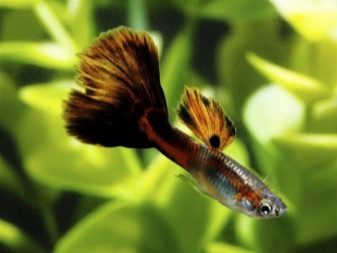
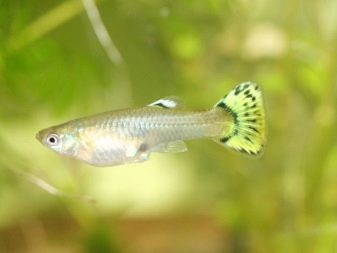
Features of the caudal fin
The male is usually clearly visible due to the bright and bushy tail, which, as a rule, has an interesting shape or increased length. The female is much more modest in this regard, her tail is narrow, short and faded.
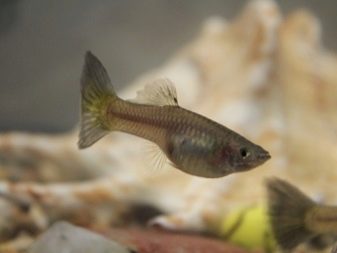
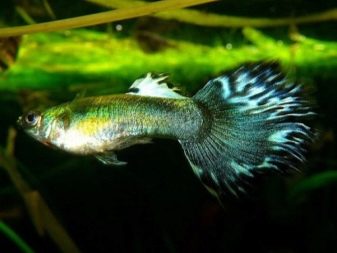
Anal fin
There is another fin on the underside of the guppy's body, which also allows sex to be distinguished. In the female, it is not particularly remarkable, it is just a comparatively short triangular fin, near which the aforementioned "pregnancy spot" should be found. In the male, this organ performs an interesting function - it replaces the penis for the "gupeshke". The fin has a typical phallic shape, elongated and relatively narrow, while its tip is slightly pointed.
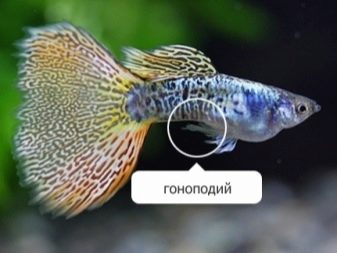
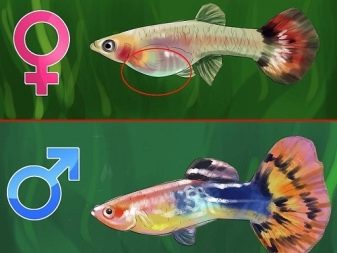
Breeding features
Guppies are easy to keep at home not only because they are easy to care for, but also because of the increased activity in the field of self-healing of the population. In their desire to reproduce, these fish are often compared to rabbits, and therefore many aquarists consciously acquire a capacity larger than it should be for the available number of individuals.
Guppies are of great interest for the reason that belong to viviparous fish. You will never see caviar from them, since such simply does not exist in nature. At the same time, the fry, only after hatching, are in great danger: their parents, who are peaceful in relation to any other species of fish, are prone to cannibalism and can devour their own young animals if they are not resettled in time.
Another curious feature of this miracle of nature is that a female guppy, fertilized once, is capable of giving offspring several times in the future without re-fertilization.
For this reason, the breeder must very reasonably calculate the volume of the aquarium, otherwise the youth will simply have nowhere to settle.

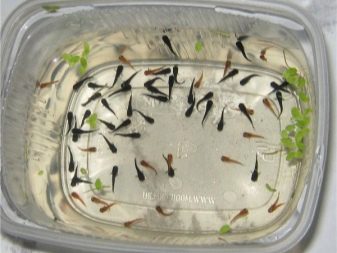
Breeding
Guppies become sexually mature at about 4-5 months of age. Before this period, pregnancy is unlikely, but immediately after the onset of maturity, a healthy pet will probably use its ability in the shortest possible time and become pregnant. The owner's task is to monitor the condition of their pets, because a pregnant female should be placed in a separate aquarium. It is possible to determine her new status due to the fact that the "pregnancy spot" has darkened, and the nearby anus has acquired a red tint and is swollen.
After identifying the pregnant woman, allocate a separate temporary place of residence for her. A large volume is not required, a small 5-liter aquarium will do as a spawning ground, an alternative can be a plastic basin of the same volume, or even a simple three-liter bottle.
The owner is required to ensure the sanitary cleanliness of the container before placing a potential woman in labor there.
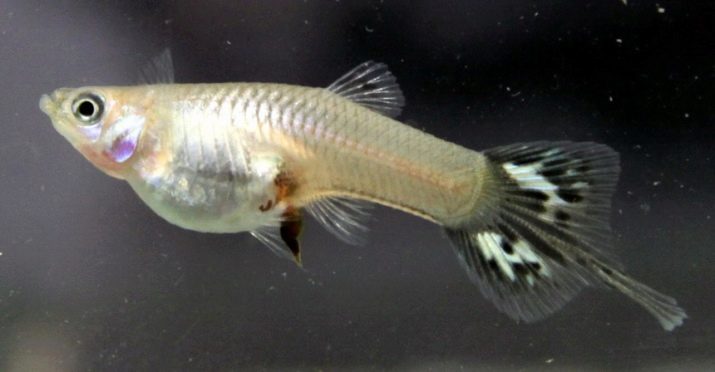
Ideally, of course, you need to create conditions similar to those in the aquarium, it is advisable not to change the main characteristics of the water, but the temperature can be increased to 26-27 ° C. Riccia and other dense plants will not interfere with spawning, so the fish will feel a little more comfortable. It is difficult to say exactly at what stage the pregnancy of the female is determined, but in general it lasts 5-6 weeks. It is worth focusing on this period.
If "ordinary" guppies need a variety of food, then the pregnant female is advised to feed exclusively with bloodworms. This is a very nutritious food, and the expectant mother's strength will not hurt. The number of newborns cannot be predicted accurately, it depends on the age of each of the parents and can fluctuate between 20-100 fry.
For reasons of potential cannibalism the newly-made mother must be immediately isolated from her own children, as soon as they are all born. Determining the approximate time is easy, because before giving birth, babies are clearly visible in the body of the pet. Having fulfilled her duty, the mother returns to the common aquarium, while the children do well without her care. They are born in a thin caviar shell, but almost immediately get out of it, flock into a flock and float higher, because it is warmer there.

Young people have an excellent appetite; at the initial stage of their development, they will not refuse to dine 4-5 times a day. At this moment, the ciliates are practically uncontested food options for fry. As the young grow up, the frequency of feeding is gradually reduced, bringing it to the "adult" standard - twice a day. At the same time, the menu is changing, which gradually includes chopped bloodworms and other food for adults.
No special care is required for a pregnant female, but her children should be under constant supervision. Brotherly feelings are not typical for them, and those who managed to grow up faster will regularly push the younger and weaker ones away from the feed, further exacerbating the gap. If you are not interested in natural selection at home, but in the productive rearing of young animals, it is worth sorting young people into groups so that in each of them all members are approximately the same size.
Under standard conditions, unsolvable problems usually do not arise, but you still need to be prepared for them.It so happens that a potential mother, who is long overdue to give birth, cannot do this in any way. Do not panic, because the problem is easy to solve. All you need is that replace half of the water in the container at a time and raise the temperature to 28-29 ° C.
Experienced aquarists claim that this method guarantees success one hundred percent of the time.
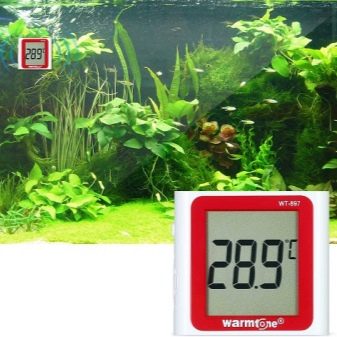
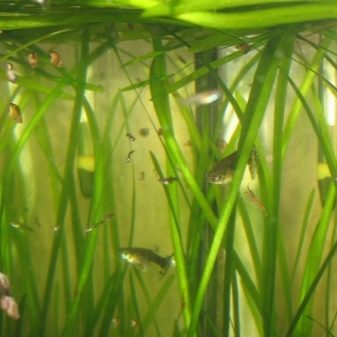
Aquarium decoration
The design features of a guppy aquarium depend on how the owner is configured. Theoretically, this fish can live in a completely empty aquarium, which is even easier to clean in the absence of soil and plants. But you must agree that it will look more like a banal jar than a full-fledged corner of the underwater world. Guppies themselves are not averse to having fun among the algae that remind of their homeland, and the whole picture will look livelier.
Plants should not be planted any, because with sharp and rapid movements, guppies with their long fins can touch hard leaves and trunks and be injured. For the same reason, it is advised not to decorate the pond with snags and stones, or to select such decorations as carefully as possible so that they do not have sharp edges. Breeding varieties of fish with long fins are much more prone to injury, therefore, the interior for them must be chosen especially carefully.
Usually used as a soil the simplest fine gravel. It is round and does not create gaps in which the fish could get stuck. It is advised to plant from plants Indian fern, swimming Riccia, Elodea canadensis and other similar freshwater species.
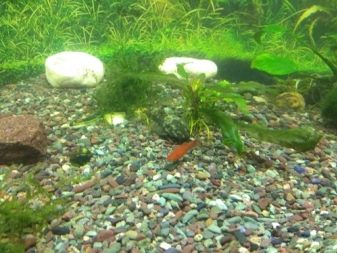
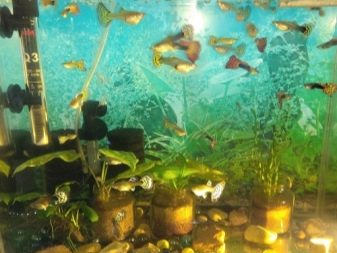
Possible problems
Although the guppy is considered one of the easiest fish to keep, it can of course also get sick and die. This species is characterized by all diseases that are considered typical for tropical aquarium fish. In many cases it would be wiser not to bring the situation to a critical one, but to carry out preventive measures in a timely manner, but if a trouble has already happened, you need to understand what to do.

Tail breaking
Some of the most common are tail problems that split and break. This not only spoils the appearance of the fish, but also directly indicates that something is wrong with it, because in some cases a part of the body may "disappear" completely. The owner is obliged to figure out what the reason is and eliminate it as soon as possible, otherwise the situation may worsen.

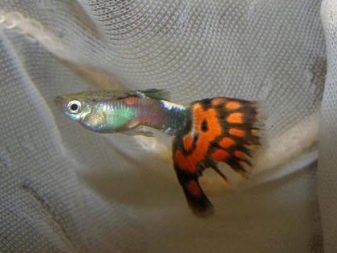
The reasons themselves are usually as follows.
- Stagnant water. Periodic water changes are necessary for the reason that the fish have nowhere to go to the toilet, and as the surrounding liquid becomes polluted, they live in their own increasingly concentrated sewage. Naturally, the body freaks out what cannot be used with benefit (nitrates and ammonia), and these same substances, getting back, provoke poisoning with possible destruction of the caudal fin. Affected individuals may not restore their original appearance, but to prevent this from happening, one must not ignore the timely replacement.
- Large-scale water change... Guppies do not accept abrupt changes in conditions, and it is difficult to find a liquid with completely identical hardness and acidity. Do not even think about relying on the stability of the water supply system, you may not feel it, but it constantly gives different water, therefore it needs to be replaced in the aquarium gradually and little by little.
- Avitaminosis. Fish, like humans, may lack vitamins. This is especially noticeable in males, which lose the brightness of pigmentation due to vitamin deficiency. In addition, their fins become brittle and sometimes seem to break for no apparent reason at all.
- Injuries. Guppy does not get into a fight, but this does not mean that other inhabitants of the aquarium are equally peaceful. In addition, the tail can be injured by accident by catching it on an object in the aquarium. The latter situation is typical for those species of fish that are distinguished by especially long tails.
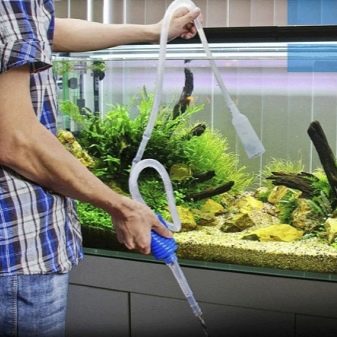
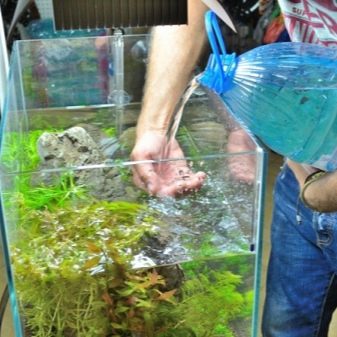
If the tail is not left at all, then the situation is even more dangerous.... This indicates either the excessive aggressiveness of the neighbors, when the problem is solved only by the method of resettlement, or about infection. With similar symptoms, adhesion of the tail fin is possible, but it is important to understand what is wrong, because the infection often involves the destruction of sick pets, followed by disinfection of the aquarium and all aquarium equipment.
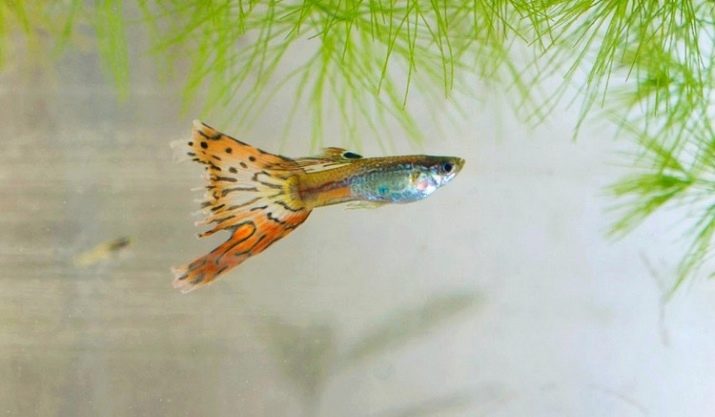
Hump formation
A curved spine is also quite common, and it can be both a variant of the norm and a sign of pathology. For "oldies" this is normal, and in adults "gupeshek" curvature can occur due to excessive overpopulation of the reservoir. The real problem arises if young individuals become humpbacked, as this can be microbacteriosis or tuberculosis.
Treatment is theoretically possible, but it is very complicated and does not guarantee a positive outcome, and tuberculosis is also contagious, so patients should be immediately isolated.
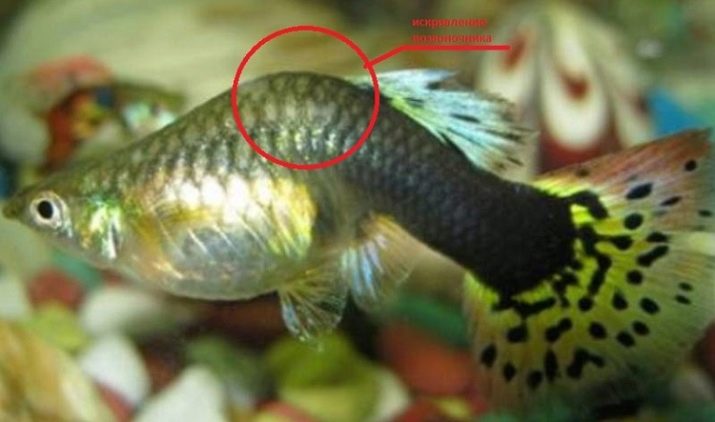
Oxygen starvation
If guppies are swimming near the surface of the water, rather than across the entire water column, this usually indicates that there is not enough oxygen in the aquarium. The reasons for this can be very different:
- excessive heat;
- long absence of cleaning the aquarium from waste;
- irregular water changes;
- excessive population density in the container.
In especially advanced cases, the fish swims vertically, head up and tail down. In addition, too dirty and stagnant water provokes guppies to jump up, because of which they can leave the aquarium altogether, because containers with them are often covered with lids. True, quite often jumps are caused by simply excessive activity of "gupeshek".
If you suspect your own lapses in care, immediately change some of the water, just do not overdo it, so that the characteristics do not change much. Replace a too cramped aquarium with a larger one, or simply move some of the inhabitants into another container. Alternatively, the filter or aerator must be moved closer to the water surface and turned on in an enhanced mode, if there is a possibility of adjustment. These measures will saturate the liquid with oxygen and remove excess waste.
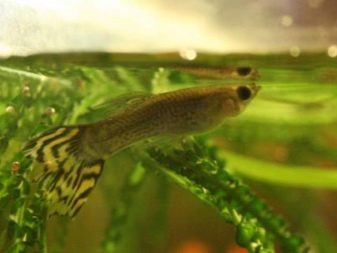
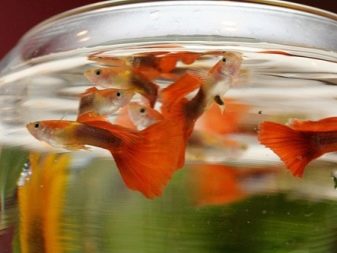
Sedentary
Another common problem is that the gupeshka is lying on the bottom, breathing heavily and looking exhausted. There are many reasons for this phenomenon; one can try to consistently improve the situation in all the proposed directions. In some cases, the symptom is genetically determined, sometimes it is directly related to old age, because even a healthy fish dies sooner or later.
A somewhat unusual reason is that in this position, the female rests from the courtship of the male... If the reason lies precisely in this, in a day or two she will feel better and she will start swimming again. For this reason, experts do not advise keeping populations with an advantage in the direction of males, since they can tire a friend to death, which is not an exaggeration at all.
Whatever the cause of the described problem, long "rest" of fish at the bottom in the absence of appetite and visible suffering usually indicates the seriousness of the situation.
Typically, if there is no improvement within two days, experienced aquarists prefer to kill the pet so that it does not suffer.

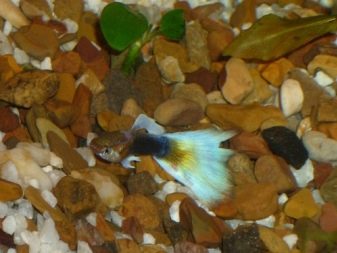
Review overview
Even among novice aquarists, most people have a good idea of what kind of guppy fish is and how to care for it. If you are one hundred percent new to this business, it will not hurt to listen to the feedback. Public opinion has it that it is one of the most versatile aquarium fish, perfect for both a starter in the aquarium industry and breeding by the keen professional. The small size of such pets allows them to be kept in relatively tight containers, it is very easy to breed, while the "gupeshka" looks beautiful and pleases the eye with its activity.
It may seem paradoxical but beginners are usually advised to abandon the brightest selection guppies in favor of slightly faded, close to natural ones. The fact is that selection is aimed at breeding individuals with attractive external data, while adaptability and immunity are ignored. For this reason, the most colorful varieties are distinguished by increased requirements for conditions of detention and an inexperienced owner may simply not survive.
By making a seemingly counterintuitive choice in favor of faded fish, you have an increased chance of success and are more likely to stay in the hobby for a long time.
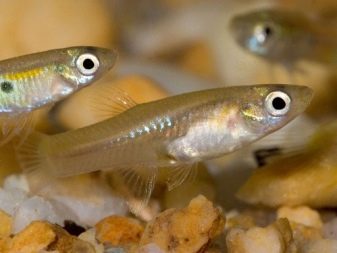
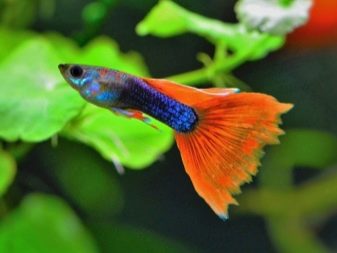
Advice
It is worth considering a few simple tips, not always obvious to beginners, regarding how how to properly contain "gupeshek".
- Do not test fish for survival. The unpretentiousness of this type of aquarium inhabitants is legendary, in some cases they survive almost in a bottle, without vegetation, aeration, filtration, or even normal feeding. The instincts of these living organisms are so strong that even in such conditions they try to produce offspring, that is, they imitate normal life activity. Nevertheless, from the owner's side this is a real mockery, and from an aesthetic point of view, such a "aquarium" does not look beautiful.
When deciding to join aquarists, please adhere to the minimum requirements, there are not so many of them for guppies.

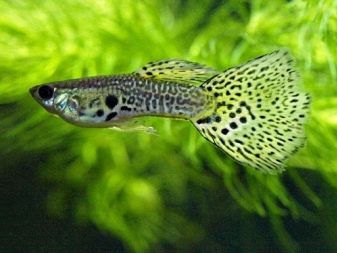
- Some owners do not consider it necessary to transfer the female to a separate reservoir during pregnancy, which is not entirely correct... Firstly, she has already become pregnant, so she should be protected from the intrusive attention of males, whose instincts from this fact do not become less pronounced. Secondly, her diet should be more nutritious, it is also completely unacceptable for her to receive less food due to the greed of other inhabitants of the aquarium. Thirdly, any adult is capable of devouring newborn babies, so the fewer outsiders there are in the spawning ground, the better for the young.
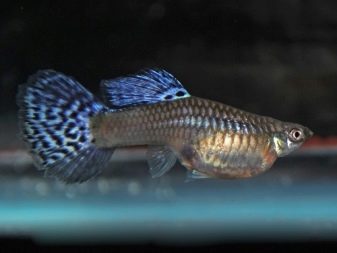
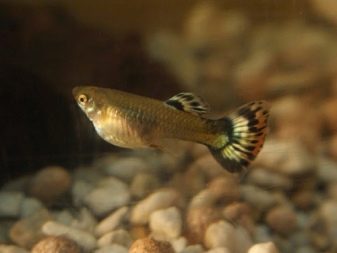
- Guppies, like people, sleep to restore the strength of the body. Most often this happens at night, because the owner must turn off the lights every night, allowing the pets to rest. At the same time, guppies do not have an internal clock, for them the night comes when it gets dark, and the schedule that has moved out usually does not become a problem. During sleep, the fish become practically immobile, they only twitch reflexively to stabilize their position and stay closer to the bottom.
Pregnant females get tired more often, they sometimes rest in this way even during the day, but if the male or his girlfriend behaves in this way, this may be an indicator of health problems.
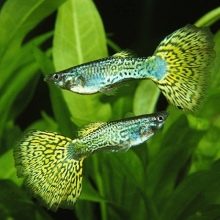
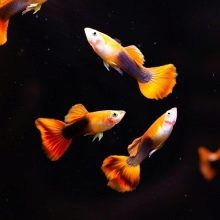
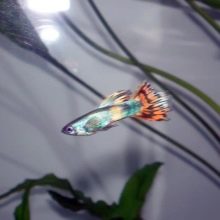
You can learn more about how to care for guppies below.








